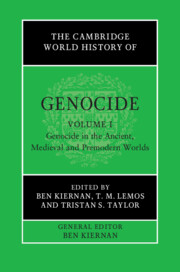Refine search
Actions for selected content:
23990 results in Ancient history
Preface
-
- Book:
- Private Associations in the Ancient Greek World
- Published online:
- 03 May 2023
- Print publication:
- 29 June 2023, pp ix-ix
-
- Chapter
-
- You have access
- Open access
- HTML
- Export citation
Additional material
-
- Book:
- Private Associations in the Ancient Greek World
- Published online:
- 03 May 2023
- Print publication:
- 29 June 2023, pp xiii-xiv
-
- Chapter
-
- You have access
- Open access
- HTML
- Export citation
Chapter 10 - Rules and Regulations of Associations
-
-
- Book:
- Private Associations in the Ancient Greek World
- Published online:
- 03 May 2023
- Print publication:
- 29 June 2023, pp 214-236
-
- Chapter
-
- You have access
- Open access
- HTML
- Export citation
Chapter 4 - The Place of Purity
-
-
- Book:
- Private Associations in the Ancient Greek World
- Published online:
- 03 May 2023
- Print publication:
- 29 June 2023, pp 86-116
-
- Chapter
-
- You have access
- Open access
- HTML
- Export citation
Chapter 1 - Associations’ Regulations from the Ancient Greek World and Beyond
-
-
- Book:
- Private Associations in the Ancient Greek World
- Published online:
- 03 May 2023
- Print publication:
- 29 June 2023, pp 1-38
-
- Chapter
-
- You have access
- Open access
- HTML
- Export citation
Subject Index
-
- Book:
- Private Associations in the Ancient Greek World
- Published online:
- 03 May 2023
- Print publication:
- 29 June 2023, pp 288-292
-
- Chapter
-
- You have access
- Open access
- HTML
- Export citation
Copyright page
-
- Book:
- Private Associations in the Ancient Greek World
- Published online:
- 03 May 2023
- Print publication:
- 29 June 2023, pp iv-iv
-
- Chapter
-
- You have access
- Open access
- HTML
- Export citation
Abbreviations
-
- Book:
- Private Associations in the Ancient Greek World
- Published online:
- 03 May 2023
- Print publication:
- 29 June 2023, pp x-xii
-
- Chapter
-
- You have access
- Open access
- HTML
- Export citation
Tables
-
- Book:
- Private Associations in the Ancient Greek World
- Published online:
- 03 May 2023
- Print publication:
- 29 June 2023, pp vii-vii
-
- Chapter
-
- You have access
- Open access
- HTML
- Export citation
Contents
-
- Book:
- Private Associations in the Ancient Greek World
- Published online:
- 03 May 2023
- Print publication:
- 29 June 2023, pp v-vi
-
- Chapter
-
- You have access
- Open access
- HTML
- Export citation
Bibliography
-
- Book:
- Private Associations in the Ancient Greek World
- Published online:
- 03 May 2023
- Print publication:
- 29 June 2023, pp 259-287
-
- Chapter
-
- You have access
- Open access
- HTML
- Export citation
Chapter 11 - Conclusion
-
-
- Book:
- Private Associations in the Ancient Greek World
- Published online:
- 03 May 2023
- Print publication:
- 29 June 2023, pp 237-258
-
- Chapter
-
- You have access
- Open access
- HTML
- Export citation
Chapter 7 - Private Affairs in a Public Domain
-
-
- Book:
- Private Associations in the Ancient Greek World
- Published online:
- 03 May 2023
- Print publication:
- 29 June 2023, pp 163-178
-
- Chapter
-
- You have access
- Open access
- HTML
- Export citation
Chapter 2 - Admission Procedures and Financial Contributions in Private Associations
-
-
- Book:
- Private Associations in the Ancient Greek World
- Published online:
- 03 May 2023
- Print publication:
- 29 June 2023, pp 39-62
-
- Chapter
-
- You have access
- Open access
- HTML
- Export citation
Index Locorum
-
- Book:
- Private Associations in the Ancient Greek World
- Published online:
- 03 May 2023
- Print publication:
- 29 June 2023, pp 293-302
-
- Chapter
-
- You have access
- Open access
- HTML
- Export citation

Dio: the Julio-Claudians
- Selections from Books 58-63 of the Roman History of Cassius Dio
-
- Published online:
- 26 June 2023
- Print publication:
- 19 October 2023

The Cambridge World History of Genocide
-
- Published online:
- 23 June 2023
- Print publication:
- 04 May 2023

Athenian Democracy
-
- Published online:
- 20 June 2023
- Print publication:
- 06 July 2023

The Age of Augustus
-
- Published online:
- 15 June 2023
- Print publication:
- 06 July 2023

Cicero's Consulship Campaign
- A Selection of Sources Relating to Cicero's Election as Consul for 63BC, Including ‘A Short Guide to Electioneering’
-
- Published online:
- 15 June 2023
- Print publication:
- 06 July 2023
